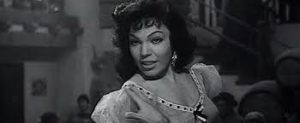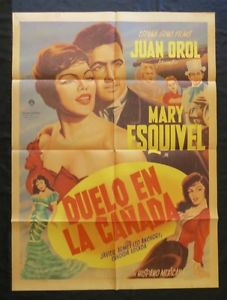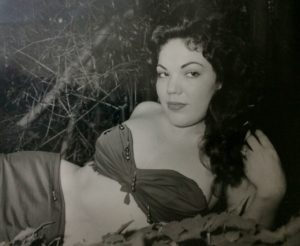 MARY ESQUIVEL, ACTRIZ, BAILARINA, CANTANTE (NACIDA EN GUINES, CUBA).
MARY ESQUIVEL, ACTRIZ, BAILARINA, CANTANTE (NACIDA EN GUINES, CUBA).
María Esquivel, conocida artísticamente también como Mary Esquivel nacio en Quemado de Güines, Las Villas, Cuba en 1934. Fue una actriz de cine y televisión, bailarina, cantante, rumbera y vedette mexicana de origen cubano.
A principios de la década de 1940 se mudó con su familia para La Habana. Desde muy pequeña empezó a declamar en la escuela, además escribía sus propios poemas. A los 14 años debutó como declamadora profesional, y al año siguiente parte a México a probar fortuna, tratando de abrirse paso en el cine. Participa en un concurso organizado por el cineasta Juan Orol en Cuba para encontrar a su nueva musa cinematográfica (después de su divorcio de la rumbera cubana María Antonieta Pons). Se casa en 1953, eventualmente se divorcia y vuelve a actuar sin mucho éxito. En 1955 se reencuentra con Juan Orol, quien estaba en Cuba precisamente para hacer una película. Esquivel se casa con Orol y parten a México.
SU VIDA ARTISTICA.
Esquivel comienza a aparecer en películas bajo la dirección de Orol. Debuta en un pequeño rol en la cinta ‘Historia de un marido infiel’ (1956), protagonizada por Rosa Carmina. Un año después, Orol le otorga su primer rol estelar en la cinta ‘Te odio y te quiero’. En 1957, tambien la actriz lanzó un disco titulado Te odio y te quiero: Mary Esquivel, Canciones de sus películas.
Le acompañaron las orquestas de Rey Díaz Calvet y Félix Guerrero.
En 1958 realiza su primera cinta sin la batuta de Orol, ‘Los salvajes’, cinta dirigida por Rafael Baledón y en la que tiene la oportunidad de alternar con Pedro Armendáriz. La cinta compitió en el Festival de Cannes de ese año, donde, sin embargo, fue destrozada por la crítica. En ese mismo año, filma bajo la batuta de Orol la cinta ‘Un farol de la ventana’, filmada en Cuba y que pasó en los cines sin pena ni gloria. Bajo la batuta de Rogelio A. González filma también ‘Mujer en condominio’, donde alterna con el célebre compositor Agustín Lara. En ese mismo año, Esquivel protagoniza una de sus cintas más recordadas, y probablemente una de las cintas más célebres de Juan Orol: ‘Zonga, el ángel diabólico’. Al fin, el “director de las multitudes”, como se hacía llamar Orol, volvía a encontrarse con la taquilla, después de tantos fracasos. Mary Esquivel comenzaba a brillar con cierta intensidad.
https://youtu.be/MFlQuCNWGgQ
En 1959 Orol y Esquivel pusieron sus ojos en España. El director Manuel Mur Oti, casi una institución en España, fue el cómplice elegido para esta nueva aventura que se tituló ‘Duelo en la Cañada’, drama de época, donde Orol únicamente co-producía. Aquí, la Esquivel, era una inocente cantante de mesón que por azares del guion se veía envuelta en un crimen no cometido. De regreso en México, la actriz actúa sin la batuta de Orol en la cinta Los Santos Reyes, donde alterna con Antonio Aguilar, Antonio Badú y Sara García, entre otros.
https://youtu.be/eDAABOWaSqA
En 1960, la pareja fílmica regresa a Cuba, donde filman ‘Tahimí, la hija del pescador’. Como compañeros de reparto Orol contrató a Rubén Rojo y a Armando Calvo. El ambiente pre-revolucionario que se respiraba en Cuba durante la filmación de Tahimí no desamino a Juan Orol, que siguio con ‘La hija del pescador” (1960). El estreno del filme rezaba la siguiente frase: “Primera película cubana que se estrena después del triunfo de la Revolución”, y el crítico René Jordán, irónico y cruel, apostilló en su crónica semanal de Bohemia: “pero artísticamente es el pasado régimen”). Orol, emocionado declaró solemne: “ahora, con estos nuevos aires de libertad, haré más películas en Cuba”. Un mes más tarde, el dúo Orol-Esquivel se marchó de Cuba para no regresar jamás.
En 1961 la actriz comparte créditos con Germán Valdés “Tin Tán” en la cinta El duende y yo.
Esquivel trabaja con Orol en otras cuatro cintas más. En 1964 realiza también una actuación en la telenovela mexicana ‘El Crisol’. Así continuaron hasta que en 1964 decidieron divorciar sus afectos e intereses y cada uno seguir su camino. Mary Esquivel se retiró de los focos y el celuloide. Después de filmar su última cinta ‘El crimen de la hacienda’ (1964), Mary Esquivel se retiró del mundo del espectáculo y durante muchos años su paradero y actividades fueron desconocidas.
Mary Esquivel Falleció en México, el 30 de junio de 2007, a las 7 PM.
Filmografía
El Crisol (1964) serie de T
La Tórtola del Ajusco (1962) (también conocida como ‘Sombras del pasado’)
El Duende y Yo (1961)
Adiós, Ninón (1960)
Thaimí, la hija del pescador (1960)
Duelo en la cañada (1959)
Los Santos reyes (1959)
Plazos traicioneros (1958)
Zonga, el ángel diabólico (1958) (también conocida como ‘the Diabolical Angel’)
Mujer en condominio (1958)
El Farol de la ventana (1958)
Los Salvajes (1957)
Historia de un marido infiel (1956)
 MARY ESQUIVEL, ACTRESS, DANCER, SINGER (BORN IN GUINES, CUBA).
MARY ESQUIVEL, ACTRESS, DANCER, SINGER (BORN IN GUINES, CUBA).
María Esquivel, also artistically known as Mary Esquivel was born in Quemado de Güines, Las Villas, Cuba in 1934. She was a film and television actress, dancer, singer, rumbera and Mexican vedette of Cuban origin.
In the early 1940s she moved with his family to Havana. She started to declaim at school, and she wrote her own poems. At age 14, she debuted as a professional declaimer, and the following year she left for Mexico to try her luck, trying to make her way into the cinema. Participates in a contest organized by the filmmaker Juan Orol in Cuba to find his new film muse (after his divorce from the Cuban rumbera María Antonieta Pons). She married in 1953, eventually divorced and returned to acting without much success. In 1955 she was reunited with Juan Orol, who was in Cuba precisely to make a film. Esquivel marries Orol and they leave for Mexico.
YOUR ARTISTIC LIFE
Esquivel begins to appear in films under the direction of Orol. She debuted in a small role in the film ‘The Story of an Unfaithful Husband’ (1956), starring Rosa Carmina. A year later, Orol gives him his first stellar role in the film ‘I hate you and I love you’. In 1957, the actress also released an album entitled I Hate You and I Love You: Mary Esquivel, Songs of her films.
She was accompanied by the orchestras of Rey Díaz Calvet and Félix Guerrero.
In 1958 he made her first film without the baton of Orol, ‘Los salvajes’, directed by Rafael Baledón and in which she has the opportunity to alternate with Pedro Armendáriz. The film competed at that year’s Cannes Film Festival, where, however, it was shattered by critics, and in that same year, it filmed the film ‘A Lamp of the Window’, filmed in Cuba, under the baton of Orol. She passed in theaters without pain or glory. Under the baton of Rogelio A. González she also films ‘Mujer en condominio’, where she alternates with the famous composer Agustín Lara. In that same year, Esquivel stars in one of her most memorable films, and probably one of Juan Orol’s most famous films: ‘Zonga, the diabolic angel’. At last, the “director of the crowds”, as he called himself Orol, returned to meet the box office, after so many failures. Mary Esquivel began to shine with some intensity.
In 1959 Orol and Esquivel put their eyes on Spain. The director Manuel Mur Oti, almost an institution in Spain, was the accomplice chosen for this new adventure that was titled ‘Duel in the Cañada’, a period drama, where Orol only co-produced. Here, the Esquivel, was an innocent inn singer who was caught up in a crime not committed because of the hazards of the script. Back in Mexico, the actress acts without the baton of Orol in the film Los Santos Reyes, where she alternates with Antonio Aguilar, Antonio Badú and Sara García, among others.
https://youtu.be/F8MEFTw-2XY
In 1960, the film couple returned to Cuba, where they filmed ‘Tahimí, the daughter of the fisherman’. As co-stars Orol hired Rubén Rojo and Armando Calvo. The pre-revolutionary atmosphere that was breathed in Cuba during the filming of Tahimí did not disappoint Juan Orol, who continued with “La hija del pescador” (1960) .The premiere of the film read the following phrase: “First Cuban film that premieres after the triumph of the Revolution “, and the critic René Jordán, ironic and cruel, added in his weekly chronicle of Bohemia:” but artistically it is the past regime “.) Orol, excited solemnly declared:” now, with these new airs of freedom, I will make more films in Cuba. “A month later, the duo Orol-Esquivel left Cuba never to return.
In 1961 the actress shares credits with Germán Valdés “Tin Tán” in the film ‘El duende and me’.
Esquivel works with Orol on four other films. In 1964 she also made an appearance in the Mexican telenovela ‘El Crisol’. So they continued until in 1964 they decided to divorce their affections and interests and each one followed their path. Mary Esquivel withdrew from the spotlights and celluloid. After filming her latest film ‘The crime of the hacienda’ (1964), Mary Esquivel retired from the world of entertainment and for many years her whereabouts and activities were unknown.
Mary Esquivel passed away in Mexico, on June 30, 2007, at 7 PM.
(READ MARY ESQUIVEL FILMOGRAPHY IN THE SPANISH SECTION)
Agencies/ Wiki/ Internet Photos/ YouTube/ Arnoldo Varona/ www.TheCubanHistory.com
THE CUBAN HISTORY, HOLLYWOOD.







